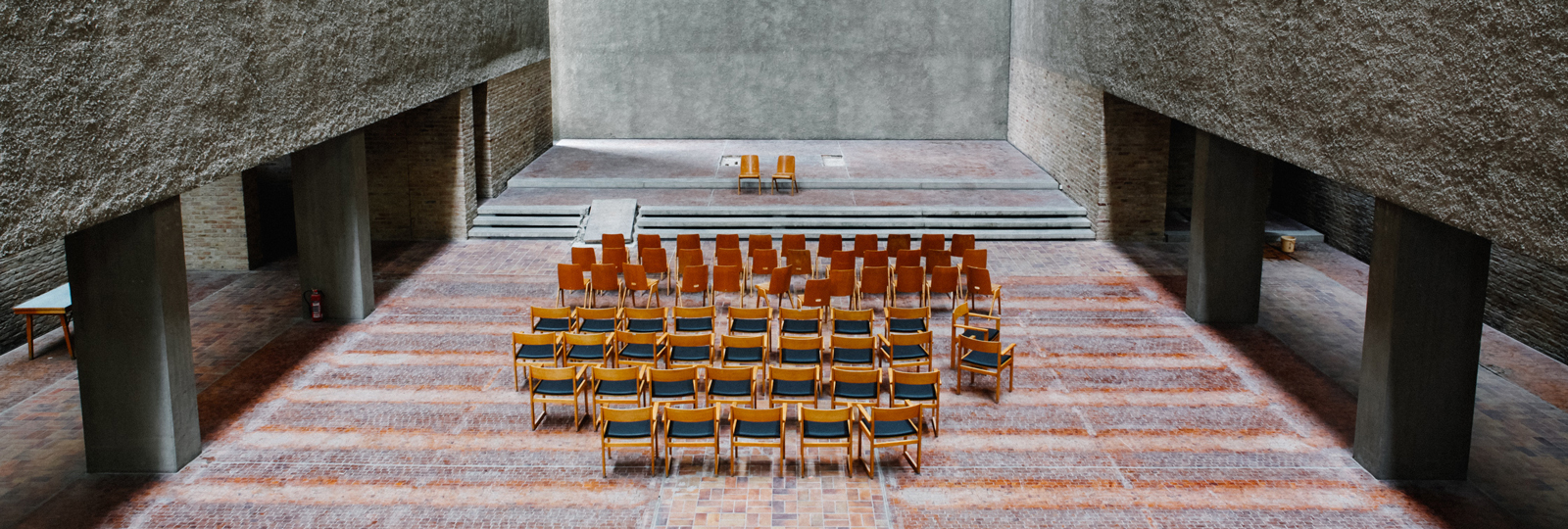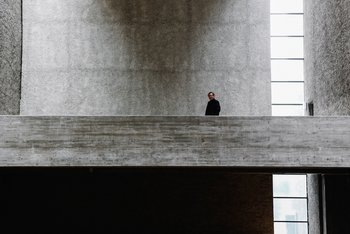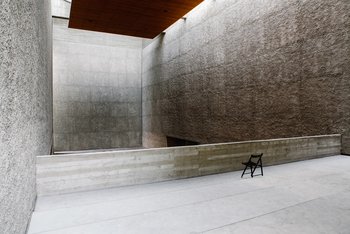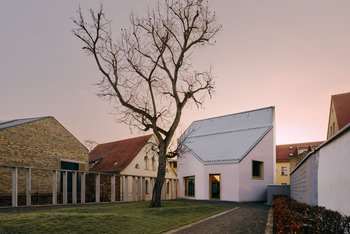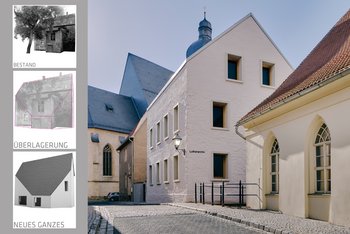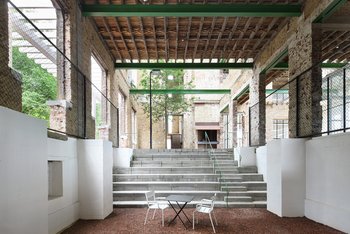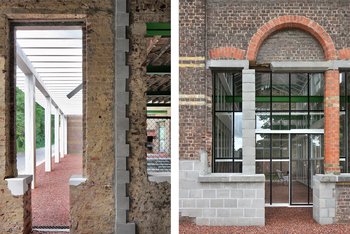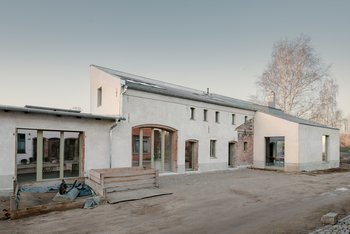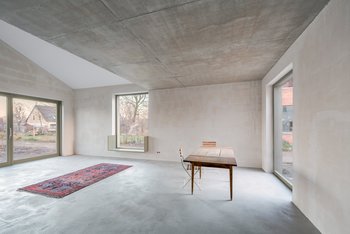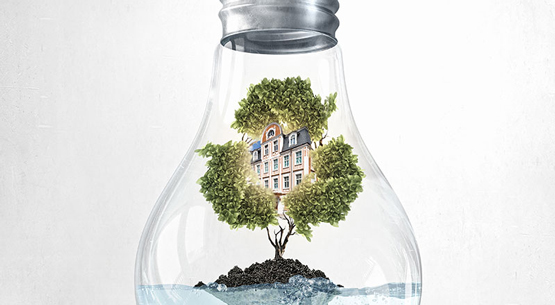Metaphors for tomorrow: Historic preservation saves, maintains and protects
Photos: Philipp Langenhein © Friends of friends, Simon Menges, Filip Dujardin
This article appeared in colore #GraphiteGray
Order the print version at: kontakt@brillux.de
It all begins with a decision. Architects take a variety of positions when dealing with protected buildings or those designated as memorials. Old and new come together, with their joints, fractures and contrasts, or reconcile a poetic synthesis that shapes the future.
"Reconstruction means destruction," says David Chipperfield when he was commissioned to renovate the Neues Museum in Berlin. Overambitious repairs and dubious recreations of past construction styles erase the layers of time, prompting silencing living witnesses to history. With their wounds and scars, some monuments reflect turbulent events in history, and these might be considered just as valuable as the original substance itself. What are architects' motivations and goals when building or working on existing structures? On the one hand, historic preservation aims to protect, preserve, maintain, and sometimes reconstruct – while on the other hand, it also sees itself as a "creative, forward-looking discipline", writes architect and monument caretaker, Thomas Will. Handling historical buildings requires a great deal of sensitivity, a sense of what is important and a structured approach. Conservation is an art in itself. A protected monument poses questions regarding architecture, monument authorities and society. Historic preservation remains a process that brings the past and future together in the present.
Complementary recreation
The heart of Berlin takes the lead in handling of historical buildings and examples of careful further construction can be found here. In 2009, the trade press, the Feuilleton and visitors celebrated the rebirth of the Neues Museum. The former ruin on Museumsinsel was to be maintained in its fragmentary state, with missing components expanded, and thus restored. The studio belonging to David Chipperfield Architects, new at the time, responded to a call in the 1990s to complete "supplementary restoration" of the Prussian Cultural Heritage Foundation with clearly visible additions. The new sections are clearly just that – new, they but fit with the old parts. "It was a Memorandum of Understanding, a vision; and I said we would retain everything that was there but complete the rest," recalls Chipperfield, who established his office location in Berlin with this project. Since preserving the existing fragments is paramount, uniform reconstruction is avoided, which not everyone likes. Historic preservation sometimes polarizes.
A gentle approach to architecture
Bruno Fioretti Marquez Architekten took an incredible approach in dealing with a partially ruined collection of master craftsmen's houses in Dessau. Again, this is not just about a listed icon, but also about a UNESCO World Heritage Site, just like the Neues Museum. Inspired by human memory, the architect interpreted the settlement with a certain degree of softness, enabling reinterpretation and a very deliberate perception of existence. According to the architects, the choices of material and texture and a drastic reduction in detail allow visitors to clearly distinguish between the existing building and what has been repaired. Since reopening in 2014, the repaired homes have been redefining debates around historic preservation.
A concrete table in a Brutalist memorial
According to the basic principles of the Venice Charter, which were agreed in 1964 as an international guideline for monuments and architects, substituting elements must "be harmoniously integrated and distinct from the existing sections so that restoration does not distort the value of the monument as a piece of art and form of documenting history". The conversion of Werner Düttmann's St. Agnes church in Berlin into a gallery for contemporary art is a logical exception to this rule: The Brutalist monument was only built in 1965–67. Brandlhuber+ Emde, Schneider have not dismantled the structural interventions. A recessed, heated concrete level on supports divides the main room horizontally, up to 20 meters high. Above this "concrete table" is the exhibition room, below which there are storage and office spaces.
"Since Düttmann deliberately worked in concrete and sprayed concrete, we deliberately did not want to go against this by using another material, but rather try to follow Düttmann's own logic," explains Arno Brandlhuber of the construction magazine Bauwelt. When dealing with the monument, his team was particularly interested in the limitations of the adaptation formulated in the Venice Charter by "a function useful to society". The congregation abandoned the building in 2004, and the former church building established itself as a site of pilgrimage for the art and culture scene, with the arrival of the König gallery in 2015. Even though the concrete table can be easily removed from the building, deliberate intervention has nevertheless been designed with extra care.
Form follows history
It's all about layers of the past in the town of Eisleben. With their design concept, architects Silvia Schellenberg-Thaut and Sebastian Thaut from Atelier ST succeed in reaching a clever compromise and satisfying both their client – the Stiftung Luthergedenkstätten (Luther Memorials Foundation) – and the monument office. While the Foundation wanted a new building for archives and event rooms for capacity reasons, the monument conservationists advocated preserving the historic emblem of Luther’s birthplace: A listed, 150-year-old existing building that had lain vacant for decades.
In line with the motto "form follows history", the architects consistently followed the specifications of the site and existing building, whereby the old construction was completely gutted and the new building was established as a homogeneous, reinforced concrete construction. Together, both layers form a kind of house within a house.
As a nod to the historical roof pitch, the roof shape on the garden side refers to the deeply pitched roofs in the village of Eisleben – in this way, the architects communicate between existing buildings, new buildings and surroundings. The historic facade on the street side was dismantled and the brick exposed to plaster and mortar sealed with a sump lime sludge. “A new whole" is what the Leipzig office calls its approach. Old and new buildings overlap to form a new overall figure. "On the one hand, it preserves the connection to the history of the building as part of the structure of Eisleben, and on the other it gives the town a space with new impetus and an independent architectural language. This approach also combined the differing interests of building owners, municipalities and monuments,” say the architects. The Luther archive was opened in 2016.
Rescuing a ruin
In 2016, Belgian architects Jan De Vylder, Inge Vinck and Jo Taillieu in the municipality of Melle in the Ghent area took on an extremely low-budget challenge; but it was one with an equally interesting and unusual suggestion. They turned existing buildings into an experiment. In this way, they were able to save and revitalize the murky, neglected psychiatric clinic PC Caritas Melle building before it was demolished. The task was to create a free space that forms a central location on the large site. The architects did not carefully renovate the historic, listed brick building (built in 1908), but instead dismantled it and opened it up. No more than an empty shell remains in the surrounding park landscape. Doors and windows were partially removed, ceilings penetrated. This radical design aims to showcase the unfinished and the decay.
In order not to hide the repair work, the team of architects repaired the cracks in the masonry with offset concrete blocks. The statics are provided by a new supporting structure made of steel that glows green between the old brick. Glass houses reminiscent of greenhouses serve as protected spaces in the exposed buildings, the roof of which opens partially to the sky without protection. This transparent house-in-house concept allows the maintenance of a special architecture without the costs of complex renovation. Indoors and outdoors connect in a surreal way, highlighting a tree that is allowed to grow through the open roof. Jan De Vylder, Inge Vinck and Jo Taillieu succeed in creating a fine interstipulation of spaces with this adventurous conversion project. Due to the raw repairs and the lightness of the add-ons, old and new grow and mesh together. The scars reveal an undisturbed, honest aesthetic that will change constantly.
Ongoing construction, melding and reinventing
Helga Blocksdorf finds the idea of prominent joints and contrasts "uncomfortable". In her renovation and renovation projects, the Berlin architect tries to "meld" old and new together so that both together form an organic unit. "Putting the marked polarity of old and new into perspective and testing the radical freedom that this allows makes it possible not only to reinvent the new, but also to build on what is old," she comments, based on Thomas Will's approach. Her Remise Rosé project is the core of reinvention.
Helga Blocksdorf has taken over an ongoing construction site in Berlin-Rosenthal. Parts of the renovation were already underway, the granular sub-base marked the new construction site, foundations would have been next – but a halt to construction imposed by the monument conservation authority turned out to be the starting shot for a new approach. The fact that her team was able to submit a radically different design to the building authority for the extension of the remise, which was subsequently used for secular purposes (which the Office for the Protection of Historical Monuments was also satisfied with), forms the basis for the residential and studio building. "Even though a listed ensemble is ranked lower than the individual monument, the attention paid to monument conservation in Berlin-Rosenthal was very high, because in the recent past many conversions in the area were not carried out in the true sense of it," explains the architect. In intensive negotiations, Blocksdorf was able to convince the monument office of their planned interventions: "Confidence-building measures are very important."
The architect always coordinates detailed drawings, models, plaster patterns, facade patterns and color shades with the state monument conservation and colleagues at the functional level who closely accompany the project. One condition of monument preservation was that the house was to be plastered again as an authentic representation of a period in East Germany, although it was a brick construction in the original construction age (approx. 1830-50). Non-colored plaster is used as a raw material because the sand of the plaster determines the color shade. "That's exactly what I'm interested in as an architect," says Blocksdorf: "How you can still create architecture within an extremely low budget." If the windows for the old remise had already been ordered with a straight lintel, she was able to convince the building owner that the windows comply with the specification sheet and were not to be lined with a piece of wood. The new living space for the family, a monolithic head building made of highly insulated tiles, seamlessly connects to the remise. Covered and overbrushed, the new melds itself to the old. "I enjoy working in monument preservation," says Helga Blocksdorf. Architects must then comply with and apply what the details noted as conditions in the building application. Protecting monuments means mutual trust; and then the result is something special.
In the field of tension between obstacle and potential
There is a field of tension for architects and planners, when it comes to protecting monuments; this tension spans protection status and rules, design and method, conservation and energy efficiency, the future and the past. Are old and new components different from each other, as required by the Venice Charter, are they separated from one another or are the old and new components melding together to form a synthesis with their very own expression? Many architects no longer see protected building stock as an obstacle, but as potential.
